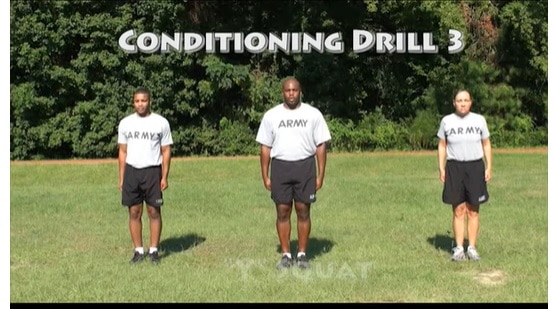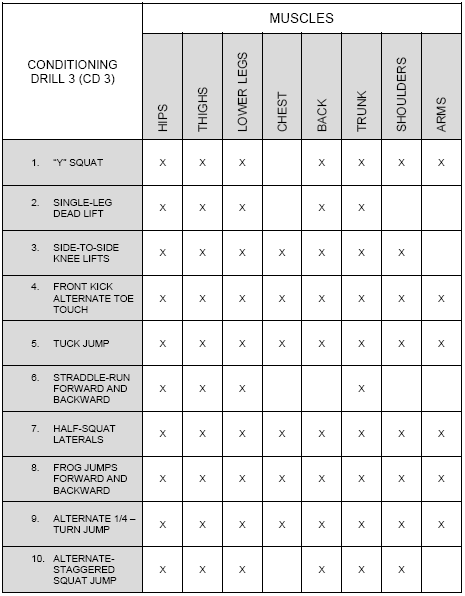
Conditioning drill 3 is conducted in a similar manner to CD 1 and 2; however, the exercises in CD 3 are more difficult and complex.
Repeated jumping, landing, and changing of body positions make this a more advanced drill with greater demands placed on the lower extremities.
The term “CD3” in an Army context typically refers to “Conditioning Drill 3.” It is one of the drills in the Physical Readiness Training (PRT) program.
- Conditioning Drill 3, similar to other conditioning drills, consists of a series of exercises designed to improve physical fitness, targeting various muscle groups and functional movements.
- The exercises are more advanced than those in CD1 and CD2, requiring increased coordination, balance, and strength.
Table of Contents
show
Level of Difficulty:
- CD 3 exercises demand more from the soldiers as they incorporate complex movements, jumps, and landings.
Applicability:
- Soldiers in the toughening phase should refrain from doing CD 3.
- In contrast, those in the sustaining phase can gradually increase their repetitions from 5 to a maximum of 10.
- To further challenge themselves, soldiers can opt to run through the drill a second time.
Focus on the lower extremities:
- The movements in CD 3 specifically target the lower body.
- It’s crucial for soldiers to ensure they’re following the correct techniques to prevent any injuries.
Conditioning Drill 3
Army Conditioning Drill 3 has 10 exercises.
- “Y” Squat
- Single-Leg Dead Lift
- Side-To-Side Knee Lifts
- Front Kick Alternate Toe Touch
- Tuck Jump
- Straddle-Run Forward and Backward
- Half-Squat Laterals
- Frog Jumps Forward and Backward
- Alternate 1/4-Turn Jump
- Alternate-Staggered Squat Jump
“Y” Squat
- Benefits: Improves lower body strength, balance, and flexibility.
- Muscles Worked: Quadriceps, hamstrings, calves, and lower back.
Single-Leg Dead Lift
- Benefits: Enhances balance, coordination, and strength in the posterior chain.
- Muscles Worked: Hamstrings, glutes, and lower back.
Side-To-Side Knee Lifts
- Benefits: Boosts hip mobility and strengthens the side muscles of the legs.
- Muscles Worked: Hip flexors, abductors, adductors, and quadriceps.
Front Kick Alternate Toe Touch
- Benefits: Engages the core, increases flexibility, and enhances balance.
- Muscles Worked: Hip flexors, quadriceps, hamstrings, and abdominal muscles.
Tuck Jump
- Benefits: Develops explosive power and cardiovascular endurance.
- Muscles Worked: Quadriceps, hamstrings, calves, and glutes.
Straddle-Run Forward and Backward
- Benefits: Boosts agility, coordination, and quick footwork.
- Muscles Worked: Quadriceps, hamstrings, calves, and hip flexors.
Half-Squat Laterals
- Benefits: Strengthens the thighs and glutes while promoting stability.
- Muscles Worked: Quadriceps, hamstrings, glutes, and abductors.
Frog Jumps Forward and Backward
- Benefits: Enhances explosive power, cardiovascular endurance, and lower body strength.
- Muscles Worked: Quadriceps, hamstrings, glutes, calves, and core.
Alternate 1/4-Turn Jump
- Benefits: Increases agility, ability to change directions swiftly, and improves balance.
- Muscles Worked: Quadriceps, hamstrings, calves, core, and glutes.
Alternate-Staggered Squat Jump
- Benefits: Combines strength and plyometric training, targets the major muscles of the legs, and enhances explosive power.
- Muscles Worked: Quadriceps, hamstrings, glutes, and calves.
Army CD3 Set Summary

Conditioning Drill 3 (CD 3) Exercises
- Exercise 1: “Y” Squat
- Exercise 2: Single-Leg Dead Lift
- Exercise 3: Side-To-Side Knee Lifts
- Exercise 4: Front Kick Alternate Toe Touch
- Exercise 5: Tuck Jump
- Exercise 6: Straddle-Run Forward and Backward
- Exercise 7: Half-Squat Laterals
- Exercise 8: Frog Jumps Forward and Backward
- Exercise 9: Alternate 1/4-Turn Jump
- Exercise 10: Alternate-Staggered Squat Jump
Latest posts by George N. (see all)
- Empowering Transactions: Navigating Firearms Sales with Proper Documentation - April 8, 2024
- Army PRT – Preparation and Recovery 2024 - March 18, 2024
- Active and Reserve Components 2024 - March 6, 2024
